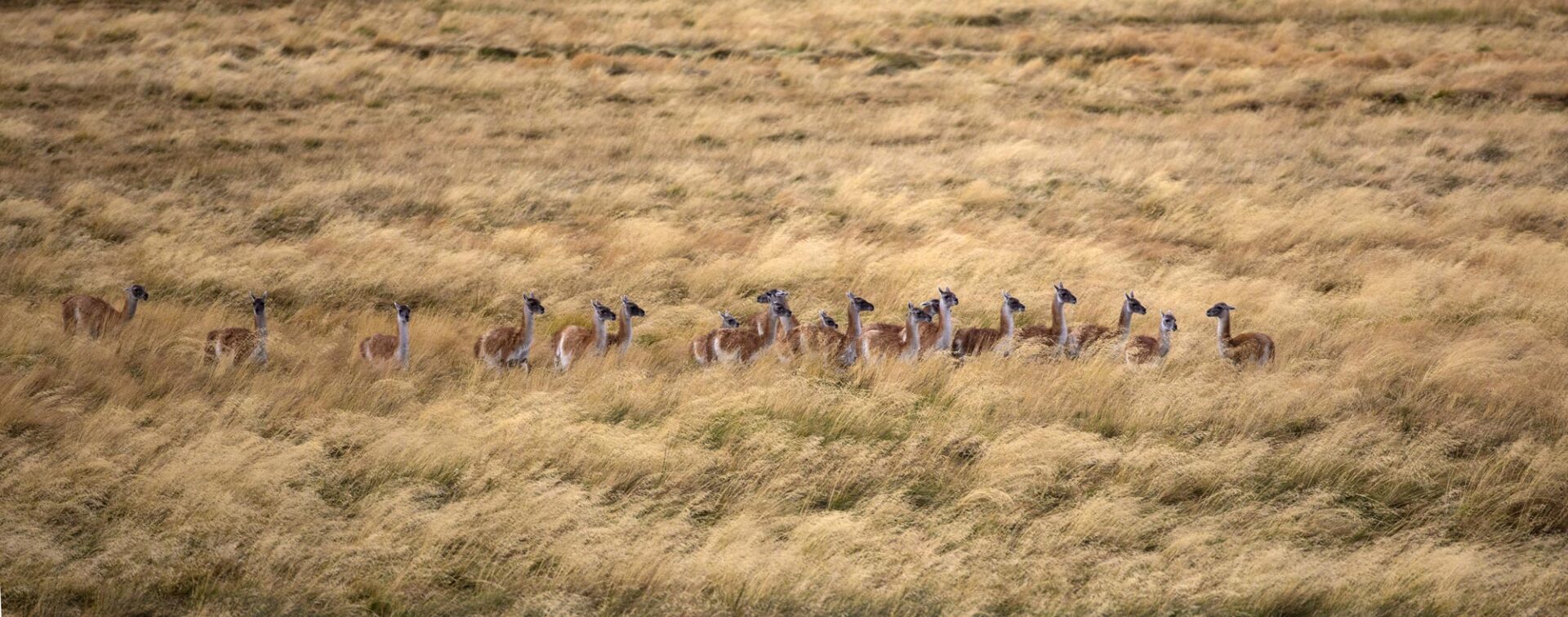
Photo: Hernán Povedano
Lama guanicoe
Before the Chacabuco Valley Estate was converted into the Chacabuco Valley sector of Patagonia National Park, extensive livestock farming meant both the control of predators (foxes, pumas, and raptors) as well as the displacement of native herbivores like the huemul and the guanaco, the latter due to competition for access to and space near foraging resources (bushes, wetlands, scrubland, and forest). To restore these degraded ecosystems, fifteen years ago, we began the process of rewilding. Since then, the monitoring and conservation of some of these species has turned into a more long-term project. As part of this work, we have implemented various initiatives leading to the gradual removal of domestic livestock, as well as the removal of fencing and posts that have limited the guanaco’s movement.
These efforts have helped the guanaco and other species begin to gain back some of their lost habitat. Currently, more than 3,000 guanacos live in Patagonia National Park, a population primarily controlled by the predation of pumas. Guanacos also provide carrion for various scavenging species, including Andean condors, caranchos (caracaras), foxes, and armadillos.
Since 2006, our team has also partnered with Conaf rangers to carry out an annual population census at the end of each summer. We are hopeful that the guanacos’ distribution will continue to grow, which will help strengthen this species’ different ecological roles, including as a low-impact herbivore, a spreader of seeds, a source of fertilization and renewal through its dunghills, and its role in the food chain as part of the diet of large wild carnivores like the puma. The guanaco is particularly important for its habitats, given that its teeth can cut vegetation without tearing. This enables it to feed without damaging plants and allowing for regrowth.
The guanaco is one of four camelids in South America. It is the largest ungulate in South America and the largest earth-dwelling mammal in Chile. Adult guanacos typically measure 6.5 feet from head to tail, standing around 3.2 feet high at the withers and weighing up to 260 pounds. Guanacos are distinguished by their wide legs, long neck, and padded hooves. The animal’s fur is brown throughout its body, with white shading underneath. Black fur on the guanaco’s face helps distinguish this species from the llama. The guanaco is covered in dense, double-layered fur that projects it from both high and low temperatures, as well as wind and precipitation. The guanaco is a ruminant herbivore, and its stomach is divided into three chambers. After an initial breaking-down process, food is returned to its mouth and chewed for final digestion.
The guanaco has a wide distribution, from the north of Peru to the islands of Tierra del Fuego and Isla Navarino in Chile’s extreme south, along with small populations in Bolivia and Uruguay and larger populations in Argentina.
In Chile, its distribution ranges from sea level to 13,000 feet above sea level. The guanaco in Chile is particularly abundant in the Magallanes Region, as well as in Tierra del Fuego, where more than 80% of the total population in Chile resides. In the rest of the country, only small and fragmented populations can be found.
Females reach sexual maturity at two years of age, but are not fertile until later. Males establish their first territories at 3–4 years of age and begin forming families around 6–8 years of age. The guanaco’s reproductive cycle is seasonal, with the female giving birth to one calf each summer, after 11 months of gestation. The calf (one per season) weighs 17 to 33 pounds at birth. Lactation lasts three months, though guanacos can be spotted suckling until nearly one year of age. Unlike most species, mothers do not lick their young.
The guanaco’s main food source comes from the herb layer, though as offerings decrease in summer, they are more likely to feed on the shrub layer. Their wide-ranging diet can also include lichens and succulents, especially in the Atacama desert, along with deciduous trees in the Valdivian and Magellanic forests. In central Chile’s mountainous regions, the guanaco behaves as a specialized consumer of herbaceous plants.
The guanaco was previously widely hunted for its hides and meat in south and central Chile, which impacted its population density. Guanaco hunting wasn’t banned until 1960 (MINAGRI Decree No. 36). In livestock-farming areas in Argentina and the south of Chile, the guanaco is still hunted today, mainly because it is considered a competitor for food, though this hunting is now less common.
Other threats to the guanaco include the fragmentation of its habitat, resource competition with livestock, and the installation of fences. These factors have reduced the guanaco’s distribution to just 26% of its original size. Dog attacks also present a threat to the guanaco. Finally, since 2002, in the upper Andes of the Atacama, there have also been reports of dead guanacos afflicted by scabies.
Common name
Guanaco
Scientific name
Lama guanicoe
Conservation status
Vulnerable (VU), between the regions of Arica, Parinacota, and Los Lagos, and Least Concern (LC) between Magallanes and Aysén, by Chile’s Species Classification System, since 2011
Least Concern (LC), by the IUCN’s red list, since 2008